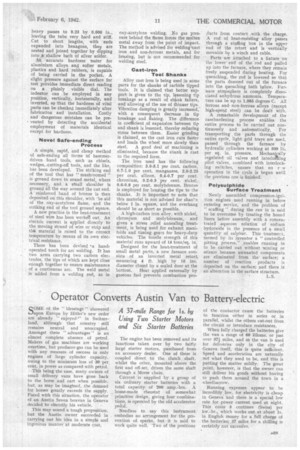Alloy cast iron is being used in some parts for
Page 25

If you've noticed an error in this article please click here to report it so we can fix it.
the shanks of carbide tipped tools. It is claimed that better support is given to the tip, lessening tip breakage as a result of shank failure, and allowing of the use of thinner tips. Vibration damping is greatly increased, with a consequent decrease in tip breakage and flaking. The difference in coefficient ,of expansion between tip and shank is lessened, thereby reducing stress between them. Easier grinding is claimed, as the cast iron cuts faster and loads the wheel more slowly than steel. A good deal of machining is eliminated, because the shank is cast to the required form.
The iron used has the followieg composition: 3.0-3.1 per cent. carbon, 0.7-1.0 per cent. manganese, 2.0-2.23 per cent. silicon, 0.4-0.7 per cent. chromium, 0.2-0.3 per cent. nickel,0.6-0.8 per cent. molybdenum. Bronze is employed for brazing the tips to the shanks. It is important to note that this material is not advised for sharilas. below 1 in. square, and the overhang should be as short as possible.
A high-carbon iron alloy, with nickel, chromium and molybdenum, and given a stress relief annealing treatment, is being used for exhaust manifolds and timing gears for heavy-duty vehicles. The tensile strength of this material runs upward of la tons/sq. in.
Designed for the heat-treatment of small metal parts, a new furnace consists of an inverted metal retort measuring 4 ft, high by 10 ins. diameter closed by a sealed door at the bottom. Heat applied externally by gaseous fuel prevents combustion pro ducts from contact with the charge. A rod of heat-resisting alloy passes through a stuffing box in the upper end of the retort and is vertically movable by a winch and cable.
Parts are attached to a fixture on the lower end of the rod and pulled up into the furnace, where they remain freely suspended during heating. For quenching, the rod is lowered so that the parts descend out of the furnace into the quenching bath below. Furnace atmosphere is completely dissociated anhydrous ammonia. Temperature can be up to 1,065 degrees C. All ferrous ancl. non-ferrous alloys (except high-speed steel) can be dealt with.
A remarkable development of the casehardening process enables the entire process to be carried out continuously and automatically. For transporting the parts through the entire cycle, light grid trays are used, passed through the furnace by hydraulic cylinders working at 500 lb. per sq. in. pressure. Mechanieally regulated oil valves and interlotEina pilot valves, combined with interlocking switches, ensure that no r w operation in the cycle is begun until the previous one is finished.
Polysulphide Surface Treatment Newly assembled compression-ignition engines need runhing in before entering service, and the problem of " scuffing " during the run in is said to be overcome by treating the honed liners before assembly with a concentrated .aqueous solution of sodium hydroxide in the presence of a small quantity of sulphur. This treatment, termed by its inventor a " controlled pitting process," ,enables running in to be carried out without 'scoring or seizure because unwanted components are eliminated from the' surface; a number of reaction products is deposited on the surface; and there is an alteration in the surface structure.




















































